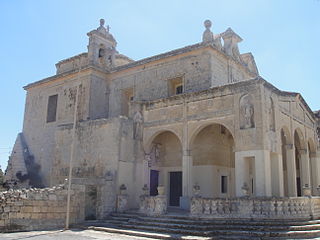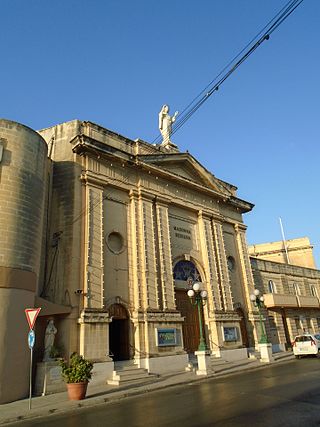
Żurrieq is a town in the Western Region of Malta. It is one of the oldest towns in the country, and it has a population of 11,823 inhabitants as of March 2014. Żurrieq is one of the 10 parishes to be documented in 1436 and it is dedicated to Saint Catherine. The island of Filfla is administratively a part of the town. The town stretches from Nigret to Ħal Far. In old times the town was had a border with Żejtun. The village of Qrendi used to be part of the parish of Żurrieq until 1618 when it was made into its own parish.

Qrendi is a village in the Southern Region of Malta, with a population of 2752 people as of March 2014. It is located close to Mqabba, Żurrieq and Siggiewi. Within its boundaries are two well-known Neolithic temples called Mnajdra and Ħaġar Qim. In this village two feasts are held annually. The feast of Our Lady of Lourdes is celebrated either on the last Sunday of June or on the first Sunday of July, with 15 August the titular feast of the Ascension of Our Lady. This feast is popularly known as the feast of Santa Maria.

In the small Mediterranean island nation of Malta the predominant religion is Roman Catholicism.

St Helen's Basilica is an 18th-century Roman Catholic church situated in Birkirkara, Malta. It is built on the baroque design by Salvu Borg and built by Mason Domenico Cachia. The design was inspired, and is similar, to the Mdina Cathedral by Lorenzo Gafa. It was built to replace the role of the main old Parish Church of St. Mary that was damaged in the 1856 earthquake. It eventually became the Collegiate Church and then a Minor Basilica. The current parish archpriest is Mons Louis Suban.

The Cathedral of the Assumption is both the cathedral church of the Roman Catholic Diocese of Kildare and Leighlin and the parish church for the cathedral parish. Located in Carlow town, the cathedral was dedicated to the Assumption of the Blessed Virgin Mary in 1833. It is known for its beautifully detailed 151 ft (46 m) spire which is one of the highest points in the town.

The Church of the Nativity of Mary is a Roman Catholic baroque parish church located in Naxxar, Malta.

The Parish Church of St Andrew is a Roman Catholic parish church located in Luqa, Malta.

The Saint Publius Parish Church, also known as the Floriana Parish Church is a Roman Catholic parish church in Floriana, Malta, dedicated to Saint Publius. It was constructed at several stages between the 18th and 20th centuries.

The Parish Church of Saint Mary, commonly known as il-Knisja l-Qadima is a Roman Catholic parish church in Birkirkara, Malta, dedicated to the Assumption of Mary. It was built in the 17th century, and it has a Renaissance design attributed to the architects Vittorio Cassar and Tommaso Dingli.

The Chapel of St Matthew, popularly known as San Mattew Iż-Żgħir, literally meaning Saint Matthew the smaller, is a small medieval chapel located beside a larger church with the same name in an area known as il-Maqluba in Qrendi, Malta. The use of the word the smaller is used that one would not confuse it with the larger St Matthew's church.

The Chapel of the Transfiguration of Jesus or simply known as Our Saviour's or Tas-Salvatur is a Roman Catholic chapel located in the village of Qrendi in the south of Malta.

The Shrine of Our Lady of Mercy also known as Chiesa Della Misericordia or simply known as Tal-Ħniena is a Roman Catholic church located i the village of Qrendi, Malta. The church is referred to as a sanctuary due to people's devotion to the Virgin Mary of Mercy.

St. Catherine's Old Church, also known as St. Gregory's Church, is a Roman Catholic church in Żejtun. The church and its complex sit towards the outskirts of the town, commanding views over Marsascala Bay, St. Thomas' Bay and Marsaxlokk harbour. The church is colloquially known as Saint Gregory's due to a traditional procession held on the first Wednesday following Easter Sunday. Its dedication to Catherine of Alexandria dates back to an original chapel on this site, which was one of the eight mother churches on Malta. The church stands next to the three cemeteries of Żejtun, dedicated to St. Rocco, St. Gregory and St. Catherine. The church's functions as the parish church of Żejtun were taken over by a new parish church, also dedicated to St. Catherine, and designed by Lorenzo Gafà.

The Archpresbyterial and Archmatrix Church of the Assumption of Mary also simply known as St Mary's Parish Church is a Baroque Roman Catholic parish church serving the village of Gudja, in Malta.

The Parish Church and Sanctuary of Our Lady of Graces is a Roman Catholic parish church in Żabbar, Malta, dedicated to Our Lady of Graces. The church was originally built between 1641 and 1696 to designs of the Renaissance architect Tommaso Dingli. Its façade, an outstanding example of Maltese Baroque architecture, was built in 1738 to designs of Giovanni Bonavia. The dome was rebuilt in the early 19th century after it had been damaged during the French blockade of 1798–1800, and it was rebuilt again in the first half of the 20th century to designs of Giuseppe Pace.

The Chapel of St Catherine is a small Roman Catholic church located in the village of Qrendi, Malta.

The Parish Church of St Cajetan of Thiene is a Roman Catholic parish church in Ħamrun, Malta, dedicated to Saint Cajetan. The church was constructed between 1869 and 1875 to designs of Giorgio Costantino Schinas, in a combination of architectural styles. The oratory and dome were added later on in the 1890s and 1950s; the latter was designed by Andrea Vassallo and it was constructed under the direction of Ġużè Damato.

The Parish Church of the Assumption of the Blessed Virgin Mary into Heaven is a Roman Catholic parish church in Żebbuġ, Gozo, Malta, dedicated to the Assumption of Mary. The present building was built between 1690 and 1726 on the site of an earlier church, and it was enlarged between 1938 and 1942. The church's interior was extensively decorated using locally-sourced travertine from cave deposits in the late 20th century.

The Parish Church of the Assumption of the Blessed Virgin Mary into Heaven is a Roman Catholic parish church in Mġarr, Malta, dedicated to the Assumption of Mary. It was constructed between 1912 and 1946 on the site of an earlier church which had existed since around 1400. The building has a large dome with an elliptical plan; this shape is said to have been chosen because of its similarity to an egg, so as to encourage residents to sell eggs to raise funds for its construction.

The Parish Church of the Immaculate Conception of Our Lady is a Roman Catholic parish church in Ħamrun, Malta. It was built between 1958 and 1963 and it took over the role of an oratory dedicated to the Immaculate Conception which had been established in Ħamrun in 1923. It has been a parish church since 1968.





















